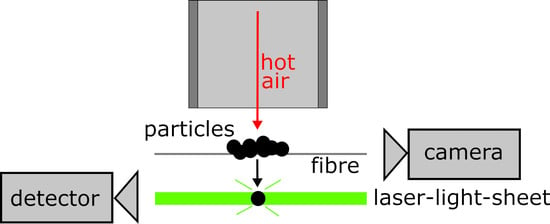A Novel Apparatus for Simultaneous Laser-Light-Sheet Optical Particle Counting and Video Recording in the Same Measurement Chamber at High Temperature
Abstract
:1. Introduction
2. Materials and Methods
2.1. The Novel Apparatus
2.2. Method for Calibration and Characterization of the Novel Apparatus
2.3. Method for Investigation of Reactive-inert Particle Structure Detachment from a Fibre Array
3. Results and Discussion
3.1. Calibration and Characterization Results
3.2. First Detachment Experiments
4. Conclusions
Author Contributions
Funding
Institutional Review Board Statement
Informed Consent Statement
Data Availability Statement
Acknowledgments
Conflicts of Interest
References
- Meloni, E.; Caldera, M.; Palma, V.; Pignatelli, V.; Gerardi, V. Soot abatement from biomass boilers by means of open-cell foams filters. Renew. Energy 2019, 131, 745–754. [Google Scholar] [CrossRef]
- Ghidossi, R.; Bonnet, J.-P.; Rebollar-Perez, G.; Carretier, E.; Ferrasse, J.-H.; Vicente, J.; Topin, F.; Moulin, P. Separation of particles from hot gases using metallic foams. J. Mater. Process. Technol. 2009, 209, 3859–3868. [Google Scholar] [CrossRef]
- Salgansky, E.A.; Zaichenko, A.Y.; Podlesniy, D.N.; Salganskaya, M.V.; Toledo, M. Coal dust gasification in the filtration combustion mode with syngas production. Int. J. Hydrog. Energy 2017, 42, 11017–11022. [Google Scholar] [CrossRef]
- Zoller, J.; Zargaran, A.; Braschke, K.; Meyer, J.; Janoske, U.; Dittler, A. Experimental Investigation of Reactive-Inert Particulate Matter Detachment from Metal Fibres at Low Flow Velocities and Different Gas Temperatures. Aerosol. Sci. Eng. 2020, 5, 21–31. [Google Scholar] [CrossRef]
- Wurster, S.; Kampa, D.; Meyer, J.; Müller, T.; Mullins, B.J.; Kasper, G. Measurement of oil entrainment rates and drop size spectra from coalescence filter media. Chem. Eng. Sci. 2015, 132, 72–80. [Google Scholar] [CrossRef]
- Wurster, S. Entrainment von Öltropfen an der Rückwand eines Faserfilters. Ph.D. Thesis, Karlsruher Institut für Technologie, Karlsruhe, Germany, 2017. [Google Scholar]
- Umhauer, H.; Berbner, S.; Hemmer, G. Optical In Situ Size and Concentration Measurement of Particles Dispersed in Gases at Temperatures up to 1000 °C. Part. Part. Syst. Charact. 2000, 17, 3–15. [Google Scholar] [CrossRef]
- Umhauer, H.; Meyer, J.; Schiel, A. A Novel Device for Single Particle Light Scattering Size Analysis and Concentration Measurement at High Pressures and Temperatures. Part. Part. Syst. Charact. 2008, 25, 119–135. [Google Scholar] [CrossRef]
- Zoller, J.; Zargaran, A.; Braschke, K.; Meyer, J.; Janoske, U.; Dittler, A. Morphology of particulate deposits formed on a single filter fibre by exposure to mixed aerosol flow. J. Aerosol. Sci. 2021, 152, 105718. [Google Scholar] [CrossRef]
- Wang, M.; Tsuji, T.; Nagano, Y. Mixed convection with flow reversal in the thermal entrance region of horizontal and vertical pipes. Int. J. Heat Mass Transf. 1994, 37, 2305–2319. [Google Scholar] [CrossRef]
- Martínez-Suástegui, L.; Treviño, C.; Cajas, J.C. Steady and oscillatory laminar opposing mixed convection in a vertical channel of finite length subjected to symmetrical isothermal discrete heat sources. Phys. Fluids 2015, 27, 63604. [Google Scholar] [CrossRef]
- Roberts, I.L.; Coney, J.E.R.; Gibbs, B.M. Estimation of radiation losses from sheathed thermocouples. Appl. Therm. Eng. 2011, 31, 2262–2270. [Google Scholar] [CrossRef] [Green Version]
- Beck, A.C. Thermal Gas Lens Measurements. Bell Syst. Tech. J. 1964, 1818–1820. [Google Scholar] [CrossRef]
- Waxler, R.M.; Cleek, G.W. The effect of temperature and pressure on the refractive index of some oxide glasses. J. Res. Natl. Bur. Stand. 1973, 77A, 755–763. [Google Scholar] [CrossRef] [PubMed]
- Xu, R. Particle Characterization: Light Scattering Methods; Springer International Publishing: Cham, Switzerland, 2002. [Google Scholar]
- Berry, E. The Reflection of Light from a Sphere. J. Opt. Soc. Am. Rev. Sci. Instrum. 1923, 7, 679–682. [Google Scholar] [CrossRef]
- Maus, R.; Umhauer, H. Collection and adhesion efficiency of biological particles on single fibers. J. Aerosol. Sci. 1996, 27, 255–256. [Google Scholar] [CrossRef]







| Calibration particle | Fit Parameter A /- | Fit Parameter B /- |
|---|---|---|
| glass: complete data | 4.78 × 10−7 | 2.199 |
| glass: without illumination, 22 °C, with fibres | 5.70 × 10−7 | 2.190 |
| glass: red illumination, 22 °C, with fibres | 5.22 × 10−7 | 2.200 |
| glass: without illumination, 22 °C, without fibres | 4.67 × 10−7 | 2.190 |
| glass: red illumination, 380 °C, without fibres | 3.75 × 10−7 | 2.218 |
| coal: complete data | 2.28 × 10−3 | 0.629 |
| coal: without illumination, 22 °C, with fibres | 5.48 × 10−3 | 0.506 |
| coal: red illumination, 22 °C with fibres | 1.44 × 10−2 | 0.361 |
| coal: without illumination, 22 °C, without fibres | 1.86 × 10−5 | 1.356 |
| coal: red illumination, 380 °C without fibres | 1.69 × 10−2 | 0.305 |
Publisher’s Note: MDPI stays neutral with regard to jurisdictional claims in published maps and institutional affiliations. |
© 2022 by the authors. Licensee MDPI, Basel, Switzerland. This article is an open access article distributed under the terms and conditions of the Creative Commons Attribution (CC BY) license (https://creativecommons.org/licenses/by/4.0/).
Share and Cite
Zoller, J.; Zargaran, A.; Braschke, K.; Meyer, J.; Janoske, U.; Dittler, A. A Novel Apparatus for Simultaneous Laser-Light-Sheet Optical Particle Counting and Video Recording in the Same Measurement Chamber at High Temperature. Sensors 2022, 22, 1363. https://doi.org/10.3390/s22041363
Zoller J, Zargaran A, Braschke K, Meyer J, Janoske U, Dittler A. A Novel Apparatus for Simultaneous Laser-Light-Sheet Optical Particle Counting and Video Recording in the Same Measurement Chamber at High Temperature. Sensors. 2022; 22(4):1363. https://doi.org/10.3390/s22041363
Chicago/Turabian StyleZoller, Julian, Amin Zargaran, Kamil Braschke, Jörg Meyer, Uwe Janoske, and Achim Dittler. 2022. "A Novel Apparatus for Simultaneous Laser-Light-Sheet Optical Particle Counting and Video Recording in the Same Measurement Chamber at High Temperature" Sensors 22, no. 4: 1363. https://doi.org/10.3390/s22041363
APA StyleZoller, J., Zargaran, A., Braschke, K., Meyer, J., Janoske, U., & Dittler, A. (2022). A Novel Apparatus for Simultaneous Laser-Light-Sheet Optical Particle Counting and Video Recording in the Same Measurement Chamber at High Temperature. Sensors, 22(4), 1363. https://doi.org/10.3390/s22041363







